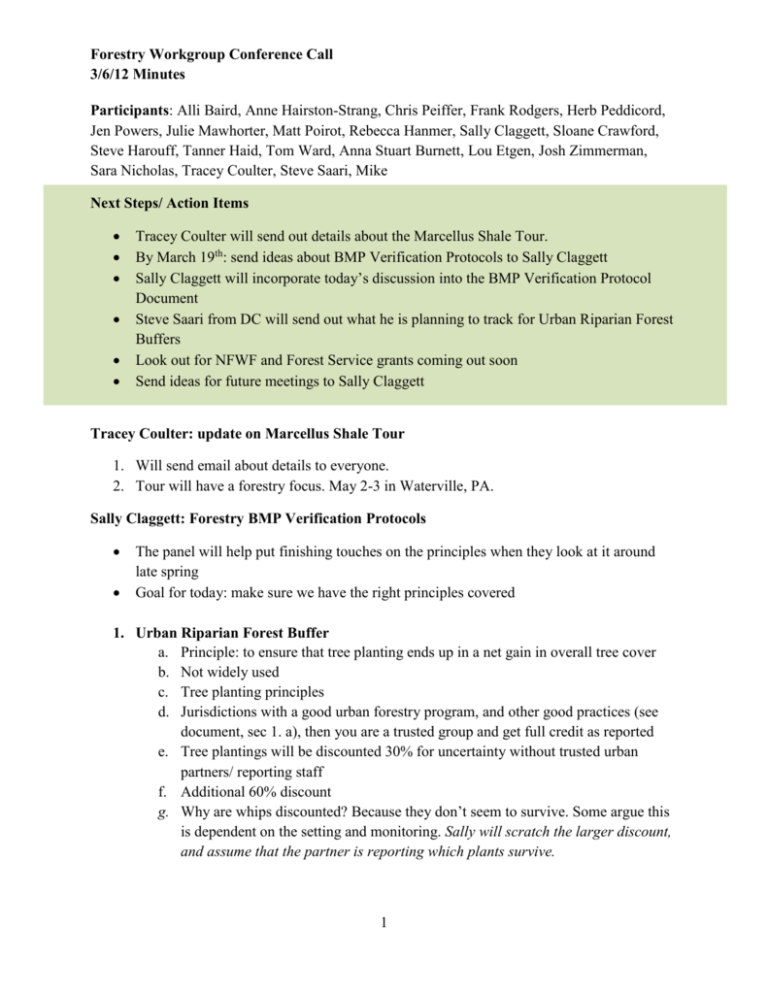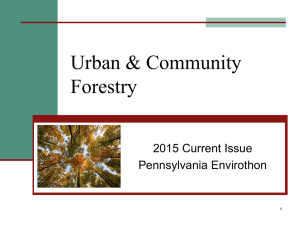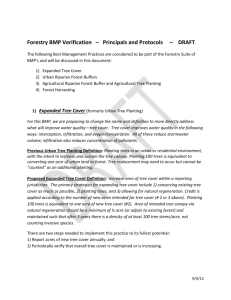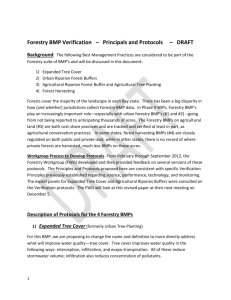3.12_minutes - Chesapeake Bay Program
advertisement

Forestry Workgroup Conference Call 3/6/12 Minutes Participants: Alli Baird, Anne Hairston-Strang, Chris Peiffer, Frank Rodgers, Herb Peddicord, Jen Powers, Julie Mawhorter, Matt Poirot, Rebecca Hanmer, Sally Claggett, Sloane Crawford, Steve Harouff, Tanner Haid, Tom Ward, Anna Stuart Burnett, Lou Etgen, Josh Zimmerman, Sara Nicholas, Tracey Coulter, Steve Saari, Mike Next Steps/ Action Items Tracey Coulter will send out details about the Marcellus Shale Tour. By March 19th: send ideas about BMP Verification Protocols to Sally Claggett Sally Claggett will incorporate today’s discussion into the BMP Verification Protocol Document Steve Saari from DC will send out what he is planning to track for Urban Riparian Forest Buffers Look out for NFWF and Forest Service grants coming out soon Send ideas for future meetings to Sally Claggett Tracey Coulter: update on Marcellus Shale Tour 1. Will send email about details to everyone. 2. Tour will have a forestry focus. May 2-3 in Waterville, PA. Sally Claggett: Forestry BMP Verification Protocols The panel will help put finishing touches on the principles when they look at it around late spring Goal for today: make sure we have the right principles covered 1. Urban Riparian Forest Buffer a. Principle: to ensure that tree planting ends up in a net gain in overall tree cover b. Not widely used c. Tree planting principles d. Jurisdictions with a good urban forestry program, and other good practices (see document, sec 1. a), then you are a trusted group and get full credit as reported e. Tree plantings will be discounted 30% for uncertainty without trusted urban partners/ reporting staff f. Additional 60% discount g. Why are whips discounted? Because they don’t seem to survive. Some argue this is dependent on the setting and monitoring. Sally will scratch the larger discount, and assume that the partner is reporting which plants survive. 1 Forestry Workgroup Conference Call 3/6/12 Minutes h. There is concern over “trees sold” getting credit if this is going towards replanting from clear-cutting. But you don’t know what it is going for; it could be going for replanting of ag land. No field verification step for “Marylanders plant trees.” i. Problem with the whole verification process, when people buy trees are they actually planting them? j. Need to not give any credit for “trees sold,” unless we have a way to register trees planted (online?). In DC a partner will also verify in person. k. Model is updated annually; want to keep reporting at the jurisdiction level. The baseline survey from the satellite is just another level of assurance to verify what jurisdictions are reporting. l. In order to assure net gain, must be tracking net loss, which we don’t have good reporting streams on. (Satellite info is good for this) m. There is a time lag when trying to measure the amount of trees planted by remote sensing. n. Need to decide on the minimum number of data fields for tracking, STEVE from DC can put forward what he is planning to track to everyone to see. o. Need to avoid double counting of tree planting for mitigation p. To verify urban tree practice, need to do it by jurisdiction (need to show a net gain) q. Can ensure net gain every 2-5 years by verifying some jurisdictions with satellite imagery tools r. Will this credit be worth the cost of managing and reporting? s. Currently, there is no credit for urban trees in CSO areas t. Could do reporting completely by satellite to show net increase, but larger trees show up more than younger trees 2. Ag Riparian Forest Buffer Tree Planting BMP Principles a. Want to avoid double counting b. Need to know how wide buffers being planted are, smaller buffers may eventually be discounted, so we need to know both length and width, not just acres c. Need to ensure projects are properly maintained, need to make sure projects that are not cost shared are in the ground and surviving d. Should check on a planting after 15 years e. Re-enrolled CREP acres can’t be recounted f. Need to ensure a net gain in riparian forest buffers: dependent on land-image analyst tool g. Need a Bay-wide baseline h. Buffer width needs to be added to the national screen, but this is unlikely to happen. Maybe NEIEN needs to change their policy from acres to width. 2 Forestry Workgroup Conference Call 3/6/12 Minutes 3. Forest Harvest BMP a. Rate of implementation needs to be determined by state every 5 years b. Differentiating between jurisdictions with regulatory programs that can verify, and states that only guess c. Should have discount for states that don’t have verification programs d. PA and NY only count what they have certainty about, rather than guessing e. Conservation districts are reliable confirmation agencies that do some on-ground verification f. Many BMPs are related to water quality g. Does BMP implementation rate mean anything or does impact on water quality mean everything h. Don’t put adaptive management in the verification strategy FWG/modelers want best info available, so if you have better data than is being requested, let Sally know ACTION: Send comments to Sally by March 19th. Sally will rework text o Will have verification panels and communication with workgroups. Document is by the end of March, and panels due by late spring or early summer Previous action items: a. Decision on what forestry BMPs would be going through review to look at efficiencies i. Looking at riparian buffer BMP and urban forestry BMP ii. Starting in the Fall, there will be another round of BMP review iii. Let Sally know if you want to be part of the review panel b. NFWF, RFP comes out early March, keep checking, more money for riparian planting (RFP is out now - www.nfwf.org/chesapeake.) iv. Proposal is due in mid-May c. Chesapeake Forest Service grant amounts to states, coming out soon. Be thinking of key projects that are needed this year to help meet our goals. Round Robin a. Ideas for future meetings: April: forest restoration strategy, May: Marcellus tour, June: Face to face? b. Lou Etgen: there is a new Executive Director in the VA office, got money to do urban re-forestry in Richmond; does anyone have any ideas for him? c. VA: had first gravel roads workshop in PA, next one is in March 15 in Charlottesville d. WV: Herb: dirt and gravel workshop in June, 3 Forestry Workgroup Conference Call 3/6/12 Minutes e. MD: have gotten together long term response plan, backyard buffer program is expanding and well received, fills a niche, road trainings on May 30-31 f. PA: agro-forestry trainings in May (at Ag progress days in Penn State). On 17th there is another conference g. STAC workshop, on crediting conservation, March 7-8, FWG will be well represented h. Send Sally ideas for future forestry workgroup meetings 4







